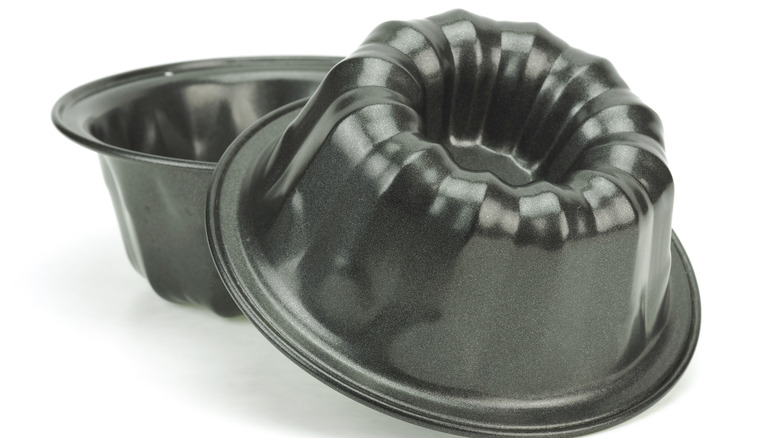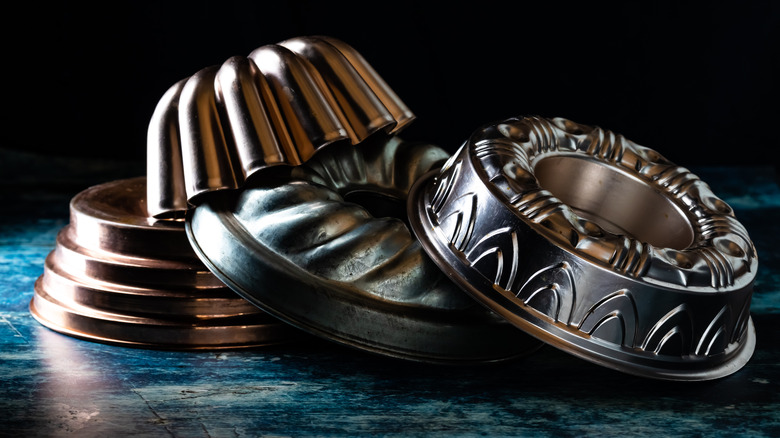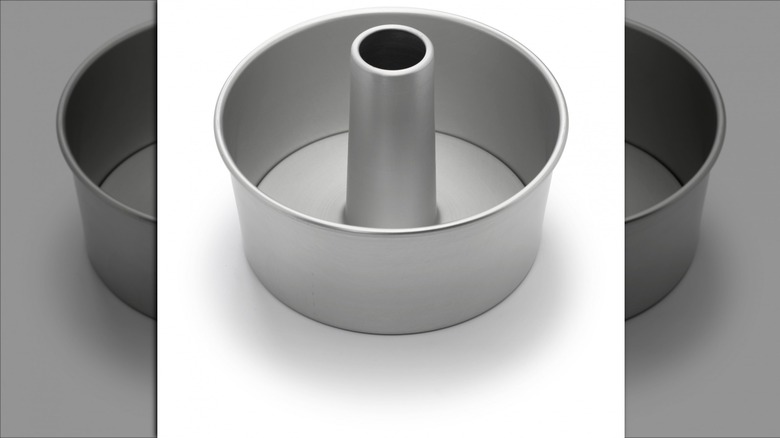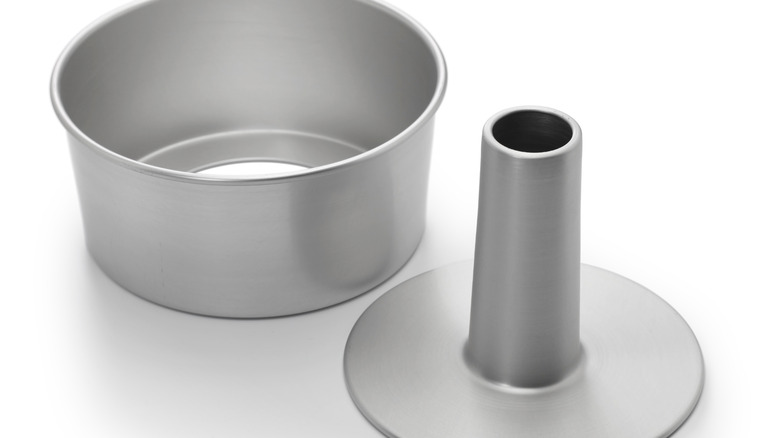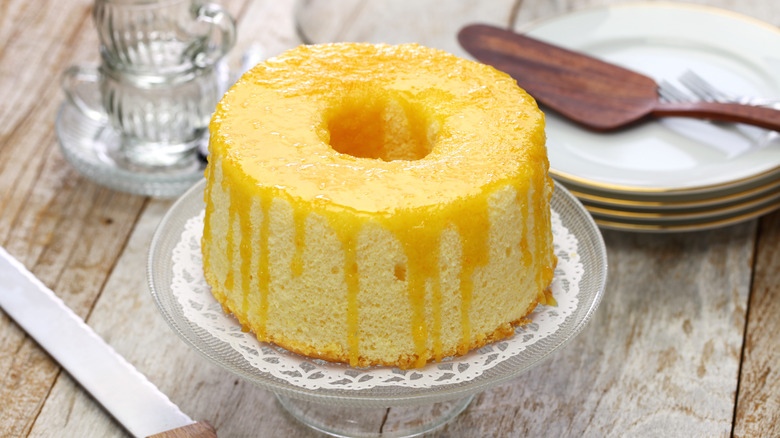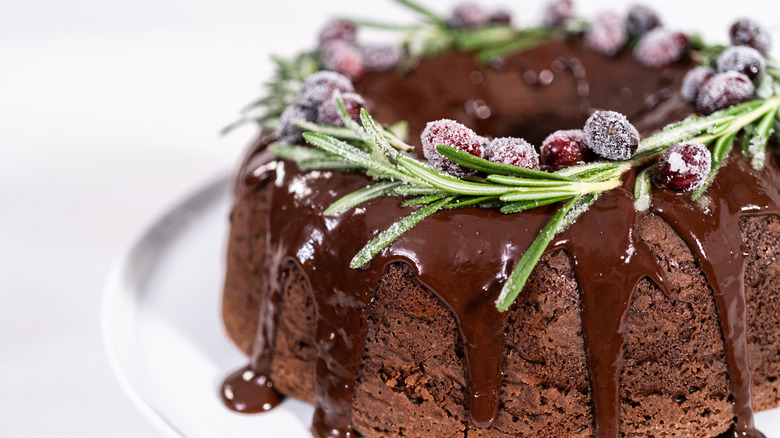The Real Difference Between A Bundt Pan And A Tube Pan
Wouldn't it be nice if we all lived in spacious homes with enormous, well-stocked kitchens and enough funds to purchase and room to store any additions our little hearts desired? Yes, well, it's a beautiful dream, but even if Bill Gates is now single, there's only one of him to go around. For most of us, we'll have to keep on making those difficult decisions as to which stuff fits into our cabinets and our budgets and which does not. Sometimes substitutions are required, such as using DIY self-rising flour made from the all-purpose kind, or making do with a Dutch oven instead of a cast-iron frying pan (or vice-versa).
One either-or decision you may have to make if you do a lot of baking is whether to purchase a bundt pan or a tube pan. While many recipes (such as a Sock-It-To-Me Cake) say you can use whichever one you please, these two pans are not always interchangeable. They are similar in many ways, yet they do have some significant differences that may come into play, depending on how you plan to use them.
How the bundt pan came to be
The bundt pan, as its name implies, is the type of pan you need to bake a bundt cake. While Food and Wine says that bundt cake recipes have been popular in Eastern Europe for several hundred years, we're not sure what those old-timey Eastern Europeans used to bake their cakes in. The bundt pan itself dates to 1950, invented by the owner of the Nordic Ware company. It's thought that he named the pan for the German word "bund," meaning "bond," but the "t" was added at a later date, perhaps for trademark purposes. Another possible reason for adding the extra letter may have been to ensure that nobody thought this innocent cake pan was associated with the not-so-innocent German-American Bund, a group who'd have liked to see a different outcome to World War II.
Bundt cakes really came into their own as a kitchen staple in the 1960s, when the first-ever Tunnel of Fudge Cake won the 1966 Pillsbury Bake Off. In the days before reality TV, this particular bake-off was big stuff, and mid-century bakers started snapping up the pans needed to recreate the cake. Some 55 years later, bundt pans now have a home in over 70 million kitchen cabinets.
A tube pan by any other name
A bundt pan is actually a kind of a tube pan, but it's like one of those elementary logic questions you find on standardized tests. All bundt pans are tube pans, so all tube pans must be bundt pans, true or false? Most definitely false.
Southern Living explains that the type of pan we're usually referring to when we use the term "tube pan" is straight-sided, as opposed to fluted, like a bundt pan. The inside of the tube pan is also uncoated, which is what makes this the best type of pan to use for light and airy cakes such as angel food. In fact, such tube pans are also often known as "angel food pans." Fun fact about angel food cakes: they don't contain any leavening agents like baking powder, but instead get all their "loft" from the air whipped into the batter. A tube pan's straight, uncoated sides allow the batter to cling so the cake doesn't collapse as it rises.
The dangerous difference between the two pans
One feature that tube pans often have but bundt pans lack is a removable bottom. Southern Living says that this makes it easier to remove the delicate cakes baked in such pans, especially since you can't grease the pan as you might do with a bundt cake. While two-piece tube pans are sufficiently structurally sound to keep airy angel food batter inside, they do have a tendency to leak when filled with anything too liquid-y.
One Allrecipes user warned that you should never, ever use a two-piece tube pan for cooking monkey bread, something that is often prepared in a bundt pan. They went on to relate a painful incident involving the molten sugar/butter topping leaking out and burning their daughter's hands when she took the pan out of the oven. Anything that's going to be at all drippy should always be cooked in a one-piece pan for safety's sake. Even if you don't burn yourself, a mess in the oven may lead to a dangerous kitchen fire.
What to cook in a tube pan
If you do a lot of cake baking, you may well find that you can't do without a tube pan. These are, after all, absolutely de rigueur for angel food cakes, and Southern Living says they should be used for chiffon cakes, as well. Taste of Home adds that tube pans can be used for baking pound cakes, sponge cakes, and even fruitcakes. You can also use a one-piece tube pan to bake pull-apart bread, although a two-piece pan might work for a bread that's not quite so "saucy" as monkey bread tends to be.
While Leaf TV suggests that two-piece tube pans aren't ideal for baking anything that doesn't have a thick, foamy batter like angel food cake, they do offer some tips for leak-proofing if a two-piece pan is all you've got. You can line it with a piece of parchment paper cut to fit the pan, then wrap the base tightly with aluminum foil. What's more, you should always place the tube pan on a baking sheet to catch any drips.
Bundt pans aren't just for baking
If you can only add one ring-shaped cake pan to your kitchen, you'll probably find that the bundt pan is the more versatile type of tube pan. Bundt pans are, of course, perfect for cooking beautiful bundt cakes as well as the aforementioned monkey bread. Jell-O salad looks best if you make it in a bundt pan, and Taste of Home also suggests using one to make a pretty ice ring for a punch bowl. They also offer recipes for jalapeño poppers, bread, and a ring-shaped lasagna that can be baked in a bundt pan, as well as tutorials for using such a pan to make a planter or even a holiday wreath for your door. Food Network has another intriguing suggestion: How about using your bundt pan to roast a delicious, crispy-skinned chicken?
One weird use for a bundt pan which could nonetheless be a lifesaver is to repurpose it as a dog's water bowl, should you have a human baby in the house. As Dog Lab points out, a baby can drown in less than two inches of water. If you can't afford one of the pricey baby-proof bowls they suggest, a bundt pan provides plenty of room for water while allowing too little room for your baby's head to slip in and contact the water.
